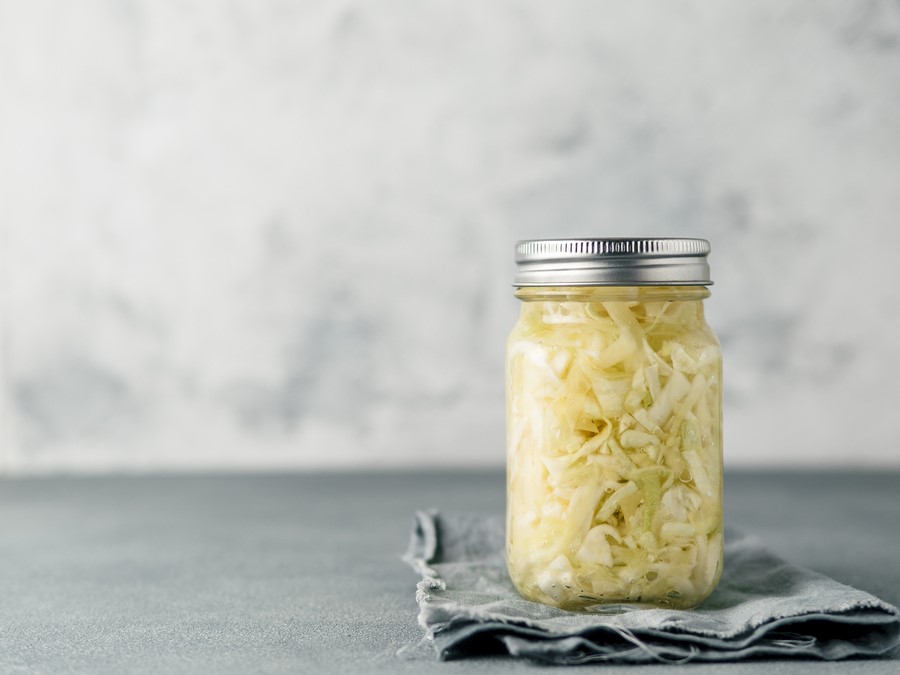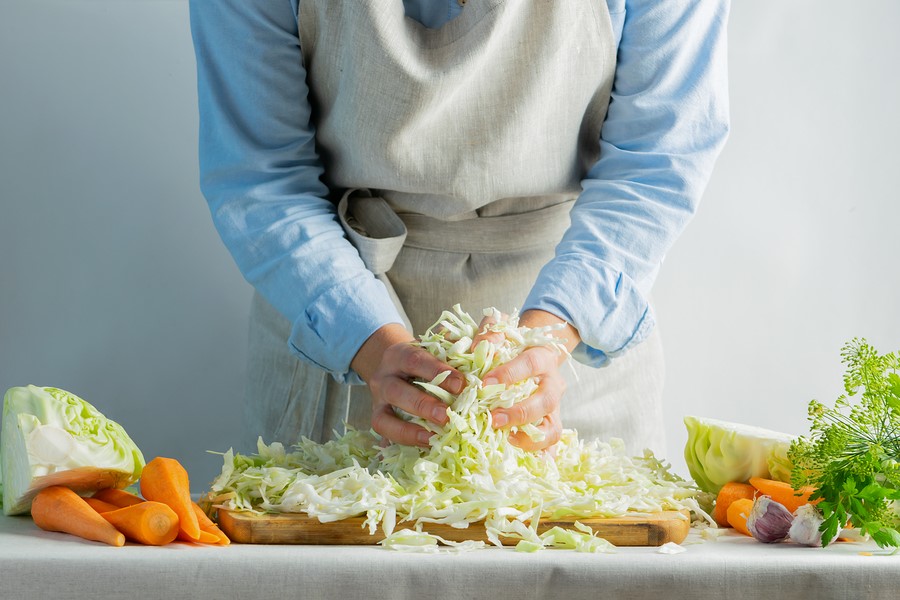Traditional Lacto-Fermented Sauerkraut

“Fermented? EW!” – Mom
This was my mother’s reaction when I offered for her to try some Lacto-fermented veggies back in the early stages of my healing journey… I kid you not. :-D
I mean, she has a point! When I used to think of “fermented” foods, the first thing that came to mind was something that has been sitting around for a while. (That’s technically not wrong!). But there’s so much more to fermentation than this.
What is fermentation?
- Fermentation is an ancestral method of naturally preserving foods and increasing their nutritional value.
- This is the dietitian equivalent of alchemy, or “turning lead into gold” if you ask me!
- Fermentation is a part of history, food science, culinary art, and also a really great hobby for all my fellow health nerds out there…
THE HISTORY:
Back in the day, before refrigerators existed, our ancestors would use Lacto-fermentation to preserve their veggies and other foods, especially at the fall harvest, to prepare for winter.
There are many different types of fermented foods out there, each originating from a different culture (pun intended):
- Sauerkraut (Germany)
- Kimchi (Korea)
- Kefir (Russia)
- Miso (Japan)
- Pickles
- Kombucha
- Yogurt
- …I could go on!
What all of these foods have in common is billions of beneficial bacteria called probiotics, which are also found in kefir, kimchi, goat milk formula, etc.) in every spoonful. Adding these “functional foods” into your routine is something that your gut and your immune system will thank you for!
GUT HEALTH & IMMUNITY:
- Bacteria and fungi of all kinds live in and on our body, outnumbering our human cells by 10:1. It’s pretty mind-blowing! Collectively, we refer to this mini-ecosystem as our “microbiome”.
- The microbiome is mostly found throughout our digestive tract.
- The “good” bacteria are considered to be the first line of defense when it comes to breaking down food particles, and also in determining what may or may not enter our bloodstream. (Technically when a food is in our stomach/digestive tract, it’s still considered to be outside the body!)
Since ~70% of our immune system is located in the gut, so the microbiome plays a MAJOR role in all things immunity (allergies, autoimmune disorders, acute viral illnesses, etc.)…
Long story short: we need to keep our microbes HAPPY!
FOOD SCIENCE…
You may have seen pickles, sauerkraut or kimchi at your local deli or supermarket… But did you know that not ALL types of pickles, sauerkraut, kimchi, etc. have probiotics?
The distinguishing factors that make only SOME fermented foods probiotic-containing, compared to many found at most supermarkets and restaurants are:
- No vinegar
- Salt must be non-iodized, non-chlorinated
- Water must be non-chlorinated (filtered, spring or well water all work)
- No heat – must be raw/unpasteurized (except for yogurt/kefir)
Vinegar, chlorine, and heat will actually interfere with the fermentation process.
So does oxygen! We’ll talk about this, but you’ll need to keep your fermented veggies submerged in a salty brine once it’s prepared.
If you’re unsure of whether or not a fermented food contains probiotics, just check the label – it should say “live active cultures” if it’s truly a probiotic food.
LET’S GET CULINARY!
As much as I love having access to traditional Lacto-fermented foods in supermarkets (like Bubbie’s, and Farmhouse Cultures to name a few), they’re very expensive. I find it’s more practical, cost-effective and empowering to make your own. Plus, it is really easy!
Sauerkraut (German for “sour cabbage”) is a great easy way to start fermenting because it literally requires two ingredients. This recipe is pretty standard and only requires 2 ingredients (unless you want to get fancy and doctor it up with some garlic or spices). Just make sure you have all the materials before getting started:
Materials: Cutting board, large bowl, wooden spoon, wide-mouth 1 qt. mason jar, and a fermentation weight
 Ingredients:
Ingredients:
- 1 head of cabbage (red or green… you choose)!
- 2 Tablespoons Celtic Sea Salt or Kosher salt
Directions:
- Make sure all equipment is clean (and wash your hands too!).
- Remove the outer layer of cabbage then chop into halves, then quarters, smaller and smaller until it appears shredded.
- Transfer to a large bowl, then add the salt.
- Begin hand-mixing (massaging) the cabbage-salt mixture for about 5-10 minutes until it begins to “sweat”. (The salt will cause the water from the cabbage to leak out, and the cabbage will shrink in size). By the end, there should be enough liquid brine to completely submerge the cabbage when it’s transferred to the jar.
- Transfer cabbage and liquid brine into the mason jar. Make sure the cabbage is completely submerged under the liquid in the jar. Cover it with a fermentation weight to ensure it’s completely anaerobic (“without air”).
- Seal tightly with the lid.
- Leave in your kitchen cabinet for 1 to 3 weeks (exposed to as little light as possible). The hotter the room temperature, the faster your cabbage will ferment. After 24 hours you should start to see bubbling. This is normal and exciting! Let it continue until it has reached your desired taste/texture. If you see any mold on top above the brine, remove it. This should not happen if all the cabbage is 100% submerged. Anything under the brine is still safe to eat!
- Enjoy a spoonful 1-4x/day around mealtimes for the best results. Try adding to salads, sandwiches, or over eggs for some extra flavor to your meal!
Custom guidelines are provided in 1:1 appointments, so don’t hesitate to reach out if you are interested in getting some extra support on your health journey.
A few words of caution:
- The cabbage in sauerkraut and kimchi may or may not be well tolerated by people with SIBO or on a low-FODMAP diet. I always encourage people to listen to their bodies.
- This recipe is high in sodium, which is not ideal for somebody with heart failure, kidney issues, or hypertension, following a low-salt therapeutic diet.
 I hope this recipe may serve as a resource for you on your journey, whether preventive or healing. Thanks for reading!
I hope this recipe may serve as a resource for you on your journey, whether preventive or healing. Thanks for reading!Jenna
Jenna Volpe, RDN, LD is a holistic-minded dietitian, nutritionist, herbalist, and self-proclaimed foodie who loves helping women to heal and live naturally using “food as medicine!”
Jenna combines her clinical nutrition expertise with ancestral wisdom, culinary passion, and counseling skills to equip women with evidence-based tools and techniques that will lead them to enjoy a life with more energy, less stress, better digestion, balanced immunity, food freedom, and more.
Learn more about Jenna’s 1:1 and group coaching programs here: www.wholeisticliving.com






